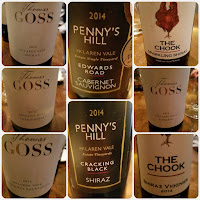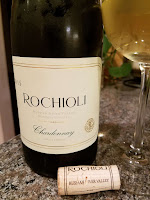One of the many benefits of attending TasteCamp is that the focus extends beyond wine and always includes beer, cider, and spirits. TasteCamp Maryland was able to leverage the spontaneous and organic craft distillery eruption in the town of Frederick; today the area supports three craft distillers when two years ago, none existed. During the weekend we were able to sample spirits from these distilleries as well as from
Lyon Distilling, located in Maryland's Eastern Shore.

The main spirits tasting occurred at
McClintock Distilling, located in a gutted shell of a 100-year-old mechanic’s garage and owned-operated by college friends Tyler Hegamyer & Braeden Bumpers. Their facility is ingenious, following the footsteps of the distillery's namesake McClintock Young - a renowned local inventor in the 1800’s who patented over 100 inventions. The facility houses many of these inventions and patents, but none compare to the engineering feat in the closed-loop cooling system and water management. This process allows the distillery to reuse tons of water during the cooling process; we are talking about 50 gallons per minute recycled and reused. Their German-made 264-gallon copper still is also ingenious in that it allows the distillers to change the focus of each batch from say vodka to gin quite easily and with a little more ingenuity allows for a dry hopping process where the botanicals seep into a gin through the vapers and not the mash.
Nevertheless none of this matters if the spirits don't shine, and in this respect, the three McClintock craft spirits do shine. The
Forager Gin is infused with "botanicals inspired by native herbs found in the Appalachian Wilderness" and is refreshing in the sense that the juniper is muted. And there appears to be equivalent citrus character. The
Maryland Heritage White Whiskey is based on a "historically derived rye heavy mash bill from pre-prohibition Western Maryland distilleries". The whiskey is then aged for 24 hours in oak which along with the rye provides just a hint of pepper and other spices. But the sweet and mellow corn and wheat provide the strongest influence leading to a very smooth spirit. Finally, the
Epiphany Vodka is distilled from Northern Italian organic wheat and double distilled and triple filtered, a process that once again provides a clean and smooth product. Nicely done.

The same evening the two other Frederick City based distilleries poured:
Dragon Distillery and
Tenth Ward Distilling Company. The former was the area's first distillery when Navy veteran and businessman Mark Lambert decided it was time for a career change. Although the distillery is named after the Dungeons & Dragons game (they readily acknowledge their geekiness), the underlying influence is Mark's great-grand father "Bad" Bill Tutt. This rebel was apparently a doctor, gambler, and moonshiner and their moonshine is based on an old family recipe. The distillery produces traditional spirits like the
Joust Gin as well as many flavored spirits such as
Fannie Tutt's Lemon Meringue Moonshine (named after Bill's wife) and the
Medieval Mint Flavored Vodka. In general I hesitate sampling anything flavored but I thought the Medieval Mint Flavored Vodka was very tasty with the chocolate finish that complimented the mint. The gin was clean and not juniper heavy - as I prefer.
Monica Pearce and business partner & distiller Kyle Pfalzer opened the Tenth Ward Distillery in July 2016 and specialize in "offbeat spirits by experimenting with unconventional ingredients, recipes, and aging techniques". The name “Tenth Ward” is a reference to the way Frederick City was divided during the late 19th century. They source locally with the grain and corn grown, malted, and\or smoked at the Rippon Lodge Farm in West Virginia. And the cider for their Applejack is sourced from McCutcheon’s, a 4th generation family owned apple manufacturing plant that has been in Frederick since 1938. At McClintock, Pfalzer poured samples of four spirits:
White Caraway Rye (80% malted rye & 20% malted barley mashed with caraway seed),
Applejack (100% apple brandy aged in used bourbon barrels),
Claude Counter Corn Whiskey (80% smoked corn & 20% malted barley), and the 120 proof
Lindsay Stunkle Rye Whiskey (80% malted rye & 20% malted barley). I was unsure about the Caraway Rye but dug the Applejack and Claude Counter. The apple-bourbon combo was very enticing and the smoked corn adds a peat character to the corn whiskey. The Lindsay Stunkle was hot; next time I look forward to tasting with a little water to dampen down the alcohol.

As mentioned previously Ben Lyon, co-owner of
Lyon Distilling poured four rums at a tasting at
Big Cork Vineyards. The distillery is located in the sailing village of St. Michael's and has been producing rum and whiskey since 2012. Here we will focus on their rum where the molasses and sugar cane juice are sourced from Louisiana and fermented, distilled, and aged at Lyon. Moving from right to left we sampled the
Sailors Reserve Rum,
Bijoo Batch Rum,
Curacao Orange Liqueur Rum, and their
Coffee Rum. The first two were solid sipping neat, full of flavor and little burn. I wasn't sure about the Curacao, but loved the Coffee. In fact went back for seconds and thirds. I need to schedule a visit this summer. Cheers.
 I recently received review samples of four entry level Chilean wines, two each from Valdivieso and Ventisquero. Valdivieso became Chile and South America's first sparkling wine producer when in 1887, founder Don Alberto Valdivieso, released Champagne Valdivieso. Close to a century later the winery added still wines to their portfolio and today work with close to a dozen grape varieties. The current winemaker is New Zealand native Brett Jackson who has quite the resume working in New Zealand; Napa Valley; Stellenbosch, South Africa; and Narbonne, France before joining Valdivieso in 1999.
I recently received review samples of four entry level Chilean wines, two each from Valdivieso and Ventisquero. Valdivieso became Chile and South America's first sparkling wine producer when in 1887, founder Don Alberto Valdivieso, released Champagne Valdivieso. Close to a century later the winery added still wines to their portfolio and today work with close to a dozen grape varieties. The current winemaker is New Zealand native Brett Jackson who has quite the resume working in New Zealand; Napa Valley; Stellenbosch, South Africa; and Narbonne, France before joining Valdivieso in 1999.  Ventisquero is a younger entity founded in 2000 in the Maipo Valley. But under the guidance of winemaker Felipe Tosso they have expanded into other regions leveraging the expanding Chilean vineyard landscape. They just don't source the grapes but own the vineyards in Apalta, Lolol and Peralillo in Colchagua, Casablanca, Maipo, Leyda and Atacama. I was sent two wines from the Reserva label, one of nine labels in the Ventisquero brand.
Ventisquero is a younger entity founded in 2000 in the Maipo Valley. But under the guidance of winemaker Felipe Tosso they have expanded into other regions leveraging the expanding Chilean vineyard landscape. They just don't source the grapes but own the vineyards in Apalta, Lolol and Peralillo in Colchagua, Casablanca, Maipo, Leyda and Atacama. I was sent two wines from the Reserva label, one of nine labels in the Ventisquero brand. 











